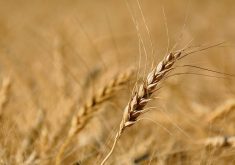A new voluntary standard for biosecurity on Canada’s grain- and oilseed-producing farms is expected to help growers build or improve on their existing farmgate-level systems at any scale.
"While some pieces of this may already be common practice, I think many producers will pick up some new tips as well to help prevent the spread of pests," Richard Phillips, executive director of Grain Growers of Canada, said in a federal release Friday.
Read Also

Senft to step down as CEO of Seeds Canada
Barry Senft, the founding CEO of the five-year-old Seeds Canada organization is stepping down as of January 2026.
The Canadian Food Inspection Agency and Canada Grains Council spearheaded a sector advisory group starting in 2011 to develop the national standard, meant as a "common approach for controlling major plant pests and diseases" including bacteria, fungi, insects and weeds, and to "complement" existing farm-level biosecurity.
"Managing on-farm risk is an important part of staying competitive in today’s market," Agriculture Minister Gerry Ritz added in the same release. "This standard offers grains and oilseeds producers a distinct advantage in the fight against pests and diseases on the farm."
The standard, released Friday through CFIA, maps out ways to "minimize and control the risk of pests and disease entering… farms, spreading within the farm or to neighbouring farms" and is "applicable to farm-level operations of all types and sizes."
"Grains and oilseeds" for the purposes of the standard refers to the 21 crops covered under the Canada Grain Act including barley, oats, rye, triticale, wheat, canola, flax, mustard, rapeseed, safflower, solin, soybeans, sunflower, beans, chickpeas, fababeans, lentils, peas, mixed grain, buckwheat and corn, plus "unofficial" grains such as canaryseed, kamut, spelt and quinoa.
"It is in the interest of all farmers to protect their crops from such pests as khapra beetle, karnal bunt, dwarf bunt, soybean cyst nematode, clubroot, blackleg of canola, and woolly cup grass," the introduction to the standard explains, noting the sector’s 2010-11 exports amounted to about $15.6 billion, not counting $5.8 billion in exports of processed grain and oilseed products.
Biosecurity measures are relevant "not only to the grains and oilseeds’ industry, but will indirectly affect other sectors of the economy such as tourism and the service sector," the standard says.
The standard offers "a methodical approach for the farmer to evaluate areas where the farm may be at risk" and "a means to develop a farm-specific biosecurity plan, or the basis for developing management strategies to mitigate biosecurity risks."
Management practices mapped out in the standard document include:
- "care" in sourcing, transportation and handling of crop inputs and supplies, including seed, fertilizer, manure and water;
- "minimization" of soil and plant material movement, such as on tillage or harvest equipment, tires/tracks or, in some cases, muddy feet;
- monitoring movement of people, vehicles and equipment, including guests, hunters, off-roaders, tourists, tradespeople, transport trucks, custom operators’ equipment and non-farm equipment such as for maintenance of utilities, pipelines or oil pumpjacks;
- cleaning equipment;
- "timely" field scouting and gauging of economic thresholds for pest control;
- beneficial crop production practices, such as crop selection, rotation and management of crop residues and pesticide resistance; and
- "communication, training and record-keeping," including documentation of risk management plans, training for farm workers, bin monitoring, sampling/testing and full disclosure to buyers to "responsibly represent" a given load of product.
As a "living" document, the standard’s authors wrote, it’s expected to need updates and improvement as new science becomes available, technology evolves and new biosecurity risks are identified, introduced and understood.
"This standard can serve as a valuable resource to producers who want to set up either a process for their farm, or as a benchmark to measure their current activities against," GGC president Stephen Vandervalk said in a letter of support for the standard in January.
Related story:
Clubroot found in Manitoba soils, March 1, 2013
















